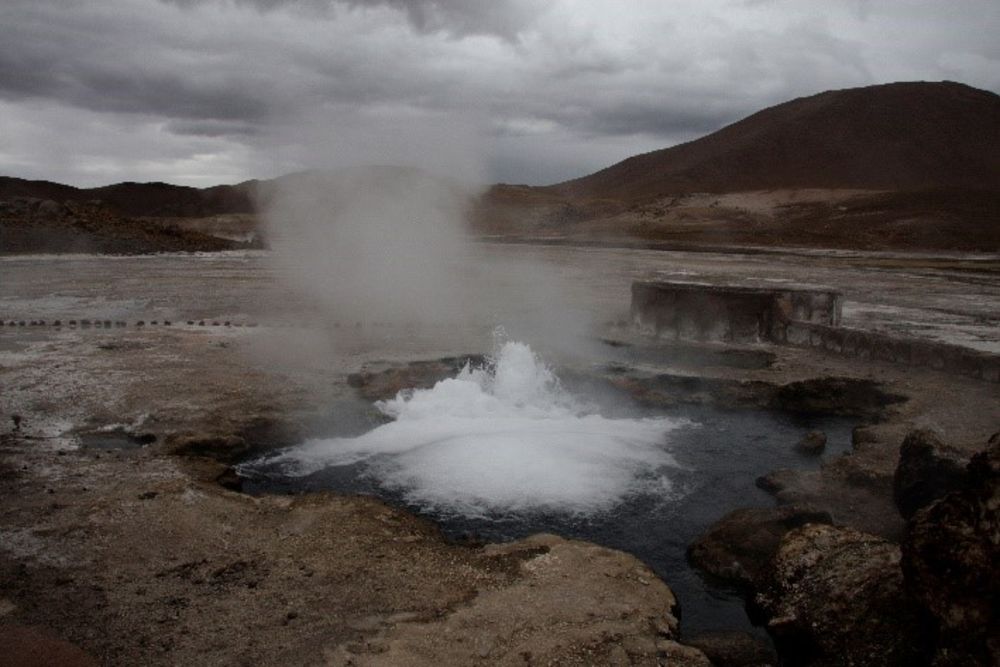Fluid Geochemistry Laboratory
- Home
- Instruments and Personnel
- Methods and Applications
- Project and Scientific Interests
- Pubblications

The Fluid Geochemical Laboratory uses various analytical instruments to measure the concentrations of major, minor and trace chemical constituents in water and gas (and also rock/soil) samples, studying their contents and distribution in natural systems. Geochemical data represent therefore an essential tool to identify the origin of fluids (water and gas), to investigate their evolution in Earth’s crust/surface (physical-chemical processes like water-rock interaction, liquid-steam separation, mineral precipitation and/or mineral segregation in shell animals) and to identify the origin and fate of contaminants.
The Fluid Geochemical Laboratory is mainly dedicated to the determination on natural waters (surface waters, groundwaters or transitional-marine waters), fluids (water and gas) from volcanic and/or hydrothermal systems and also geothermal brines or fluids from producing geothermal wells. After suitable sample treatment, solid samples (minerals, rocks or animal shells) can be also analysed. The development of suitable analytical methods to avoid interferences (e.g. due to matrix effect) during analyses is taken into account, especially for samples characterised by high TDS values.
Main research topics are geothermics, volcanology, hydrogeochemistry, hydrogeology and isotope hydrology, climate change, climatology and paleoclimatology.
Instruments
ICP-OES - Inductively Coupled Plasma Optical Emission Spectrometry:
ICP-OES is a well-established multielement analytical technique for the determination of elements in liquid form samples, in the range of concentration between g/L to µg/L. Typically, water samples and geologic samples (e.g. rocks, soils or minerals - after dissolution in acid solution) are analysed after suitable pre-treatment and/or dilution. The laboratory is equipped with a Perkin Elmer Optima 2000 DV, which offer the possibility to use the torch in axial and radial view, choosing the best solution in terms of sensitivity and control of interferences. The Optima 2000 DV is also equipped with the cold hydride generator system to perform analysis of Hg, As, Sn at µg/L levels with no matrix effect.
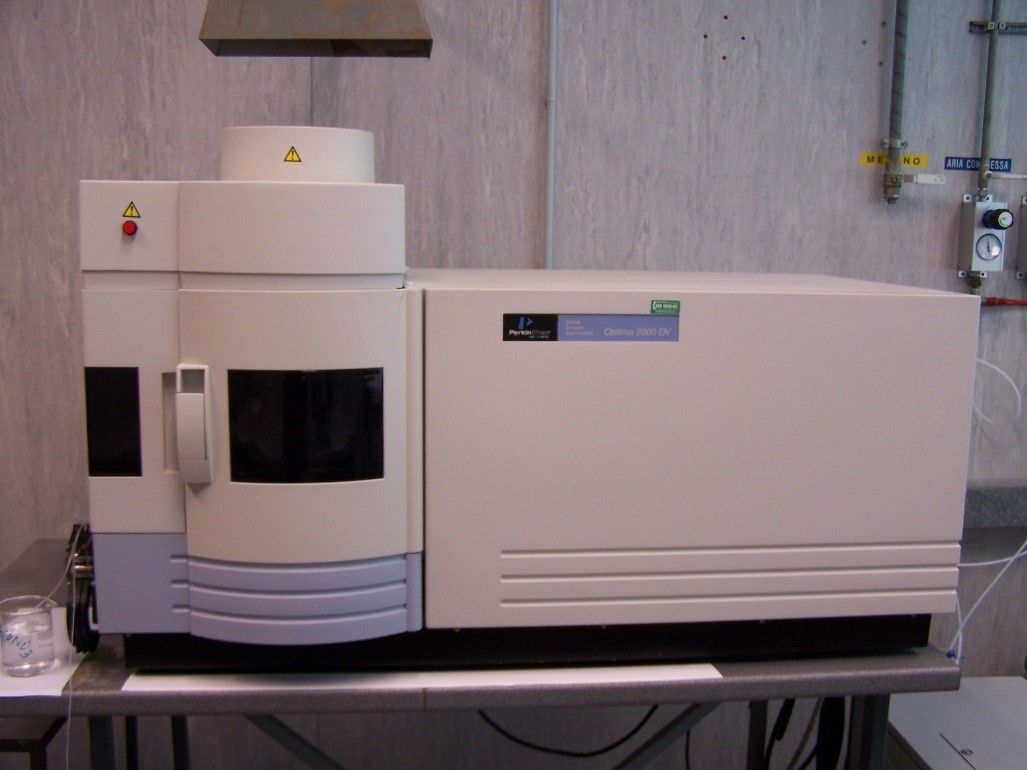
ICP-MS - Inductively Coupled Plasma Mass Spectrometry:
ICP-MS is a well-established multielement analytical technique to determine elements at low-concentrations (µg/l) and ultra-low-concentrations (ng/l) in liquid form samples (i.e. water samples or geologic samples – rocks, soil or sediments after dissolution in acid solution).
The laboratory uses Agilent 7800 ICP-MS, which offers high performance in terms of matrix tolerance (up to 3% in TDS), wide dynamic range (up to 11 order of magnitudes), and effective control of polyatomic interferences using helium mode with kinetic energy discrimination (KED).
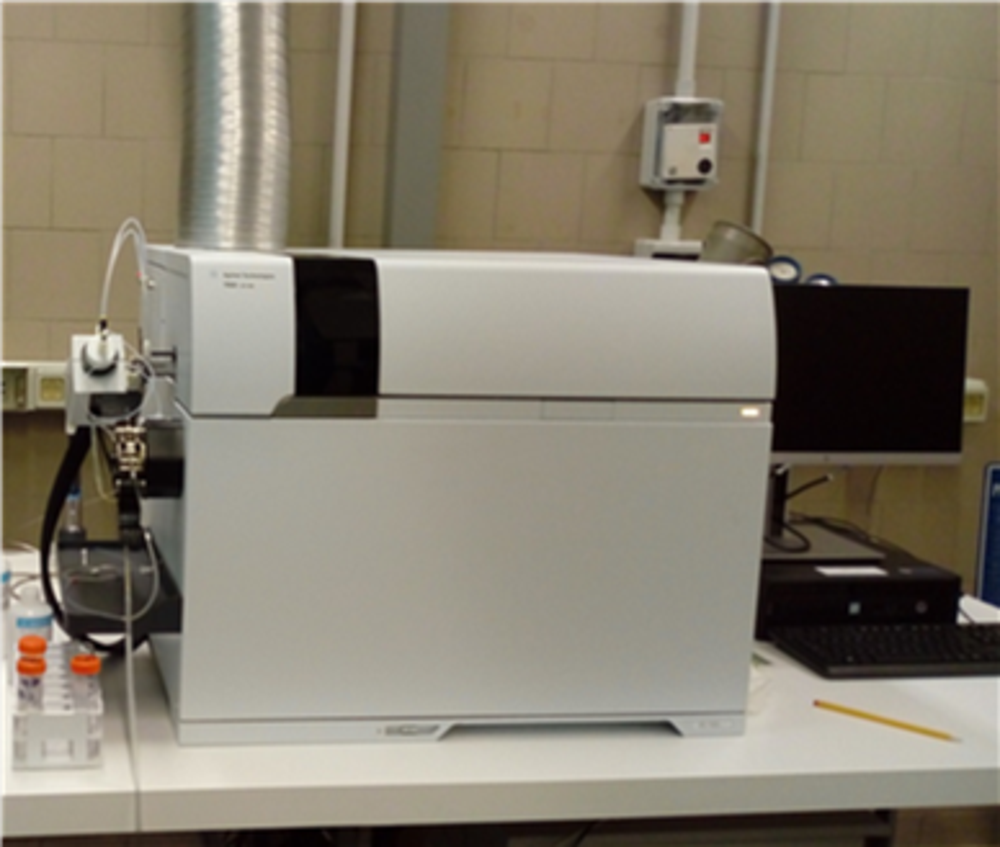
IC - Ion Chromatography
IC is the chromatographic technic used to separate ions and polar molecules present in a liquid state mixture. It uses the different affinities between dissolved ions or molecules towards a specific solid stationary phase contained in the chromatographic columns. The laboratory has two chromatographs (Metrohm 883 Basic IC Plus and Dionex DX-100), which are equipped with column for anion analyses, chemical suppression and conductivity detectors.
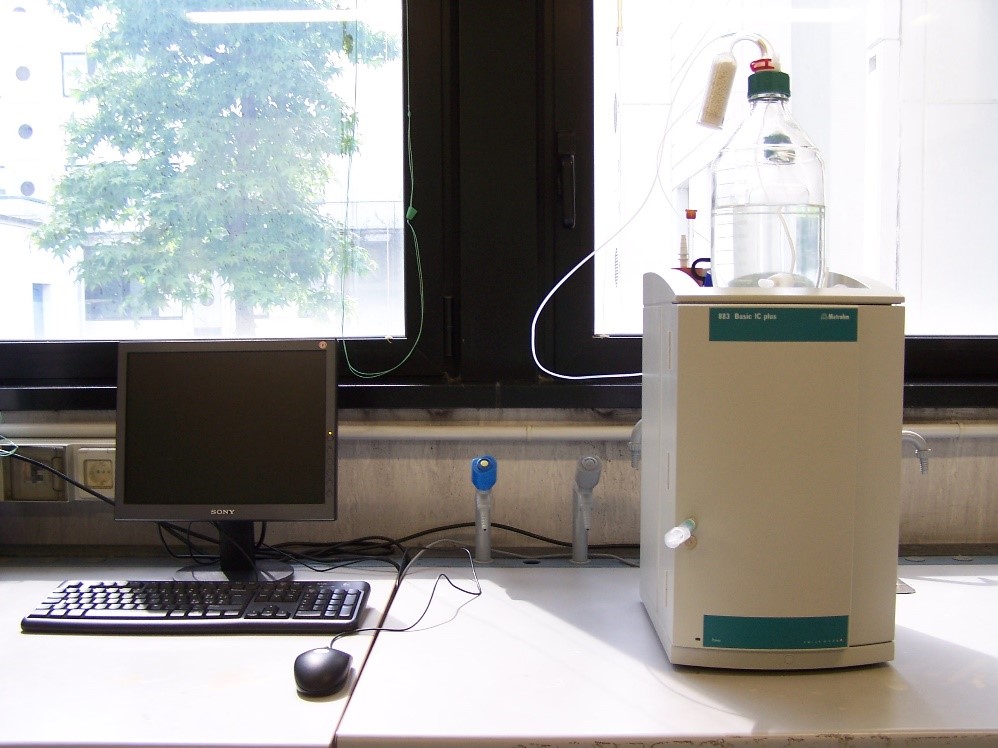
ISE - Potentiometry
Potentiometry is an analytical method based on the measurement of electrical potential established between two electrodes, in which one is used as reference and the other as working electrode. Ion Selective Electrodes (ISE) are electrodes sensitive to specifics elements/compounds and can be used to measure their concentrations directly in a liquid solution. The laboratory has an automatic titrator Metrohm 905 Titrando, which is equipped with ISE electrodes for F (range of measurements 10-6 mol/L - saturation) and NH3 (<10-2 mol/L). Electrodes for acid-base and argentometric titration are also available. The system is equipped with sealed titration vessel for measurements in controlled atmosphere conditions.
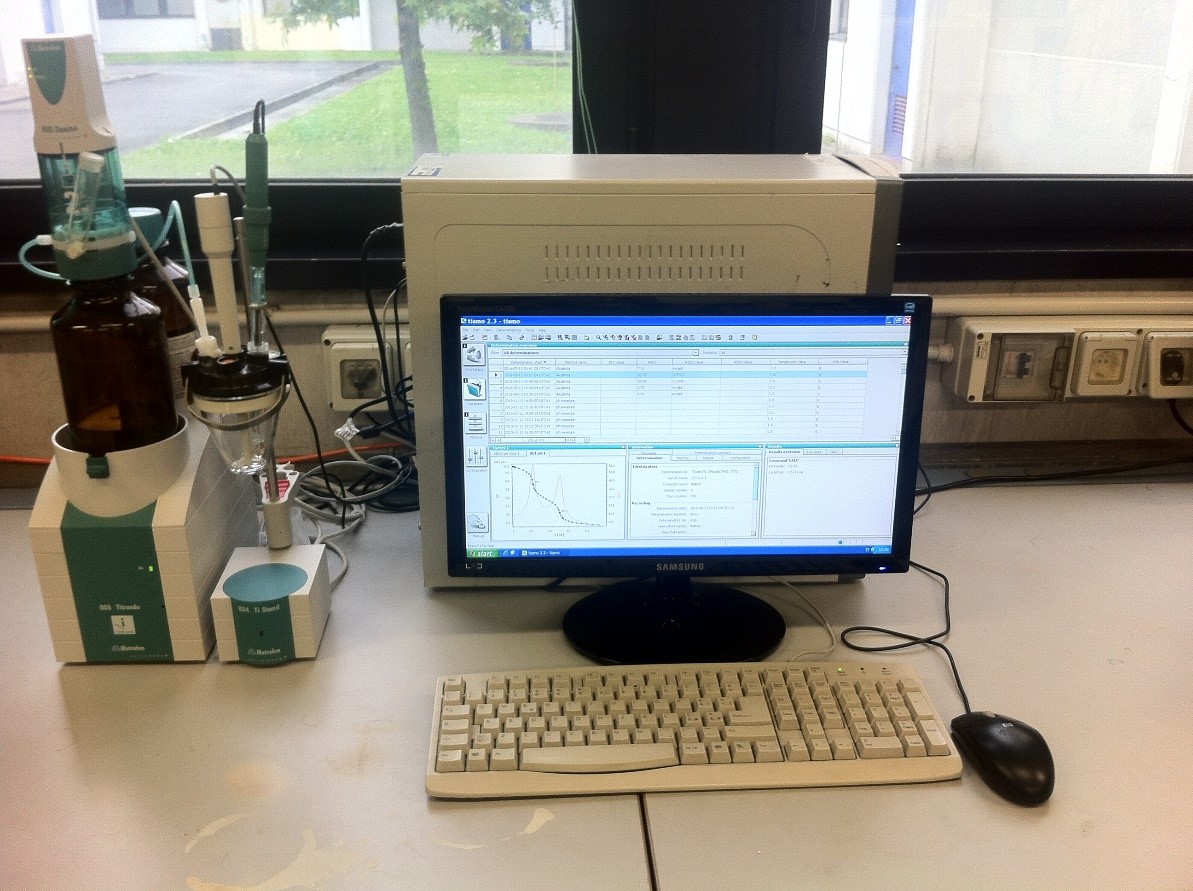
UV-VIS spectroscopy
UV-VIS spectroscopy is an analytical method commonly used for quantitative determination of compounds in a liquid state solutions. It measures the absorbance or transmission properties. The laboratory is equipped with Jasco V-530 spectrophotometer, having a range of wavelength 190-1100 nm.
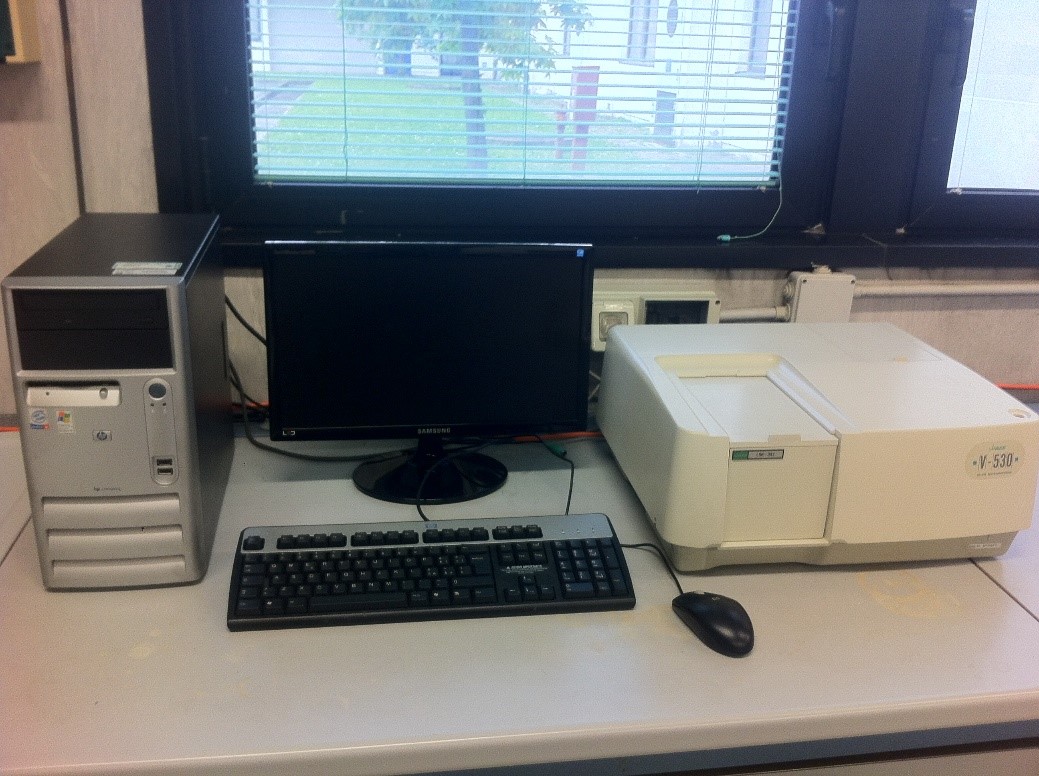
GC (Gas chromatography) and GC-ICP-MS
GC is the most suitable analytical technique to determine the chemical compositions of major, minor and trace components in gas mixture (from % to ppm in volume). Depending on the kind of columns and detectors, the GC technique provides, respectively, qualitative and quantitative information regarding a very large number of inorganic and organic compounds. Samples from geothermal/volcanic gas emissions, cold gas manifestation and dissolved gas are routinely analysed.
List of GC-instruments available:
- Agilent 7890A, double channel GC equipped with capillary columns and two Thermal Conductivity Detectors (TCD);
- Perkin Elmer Clarus 580, single channel GC equipped with capillary columns and TCD and Flame Ionization Detector (FID), coupled (via 10 way-valve) with Perkin Elmer Autosystem XL, singe channel GC equipped with packed column and TCD detector;
- Carlo Erba 5800 Megaseries, single channel GC equipped with packed column and Reducing Gas Detector (RDG, specific for H2 and CO at ppm level);
- Varian 3900, single channel GC equipped with capillary columns and Flame Ionization Detector (FID).
All GC instruments are equipped with an external 6 or 10-way valve as introduction system, which allows to introduce samples at controlled pressure, also lesser than the atmospheric one. Calibration of the instruments is performed using external standard introduced at different pressure (i.e. different partial pressure of each components) and every each 6-7 samples.
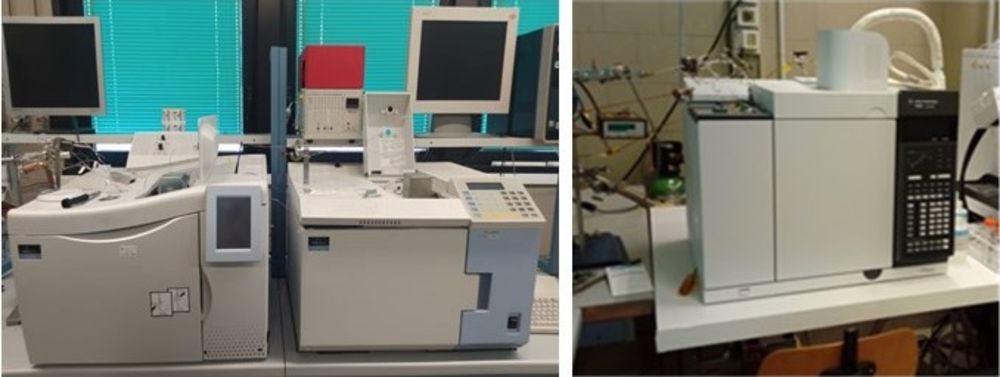
The GC Agilent 7890A instrument can be interfaced with the Agilent 7800 ICP-MS by means of an external GC transfer line. The use of ICP-MS as detector for GC (GC-ICP-MS) represents one of the most sensitive “hyphenated” method for speciation analysis (detection limits can reach a ppt level). Moreover, it allow to enlarge the applicability of the ICP-MS in the detection of elements not commonly or impossible to measure by ICP-MS with conventional nebulizer system (such as S, C, P, Cl).
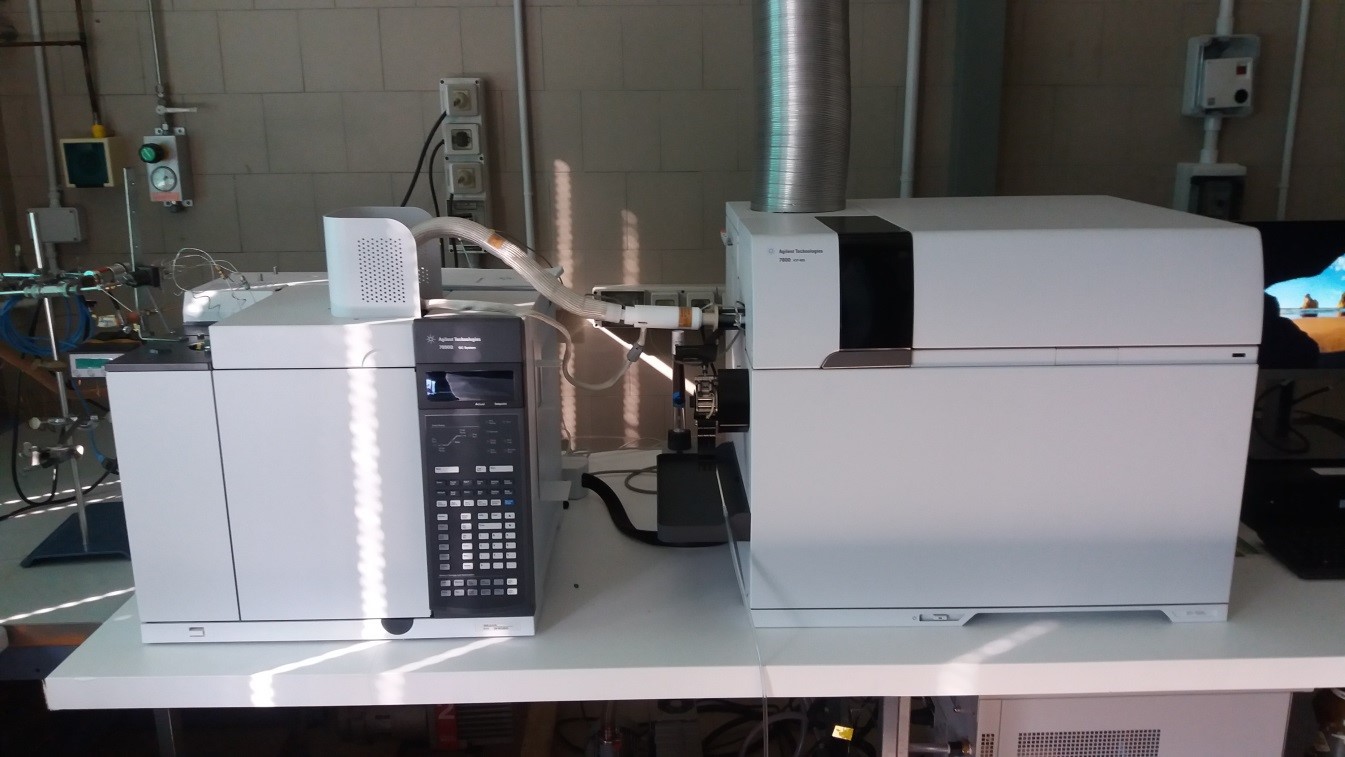
Other bench equipment
- Radiometer Analytica CDM210 conductivity cell with temperature sensor for high precision measurements of the electrical conductivity in liquid solutions. Two conductivity probe are available: CDC267-9 (cell constant 0.09-0.12 cm-1, range 0.001 µS/cm ÷ 2 mS/cm ) and CDC641T (cell constant 0.72-0.95 cm-1, range 0.01 µS/cm ÷ 200 mS/cm);
- Eutech Instrument Ion 2700 for pH measurements in liquid solution (Resolution up to 0.001 pH and Accuracy ±0.002 pH + 1 LSD)
Staff
Dr. Matteo Lelli (Researcher CNR – Head of the laboratory)
Dr.ssa Brunella Raco (Researcher CNR)
Dr. Francesco Norelli (Technician CNR)
Dr.ssa Sandra Trifirò (Technician CNR)
Contacts
050 6212321 (Dr. Matteo Lelli)
E-mails:
Methods
Field activities represent one of the most important step for any study of natural systems since they are necessary to: a) measure the parameters subjected to modification after sampling; b) treated the samples collected, stabilizing chemical compounds for subsequent laboratory analyses.
Waters
Portable instruments for measuring temperature, groundwater subsidence, pH, electrical conductivity, redox potential and dissolved O2 are available for field work. Total alkalinity is systematically determined directly on the field by means of acid-base titration, using a microdosimeter (minimum quantity dosed 1 µL) containing HCl (depending on the type of study, other parameters are also determined on the ground such as for example sulphides ). There are also specific probes for continuous monitoring of water level in wells or piezometers, temperature and electrical conductivity.
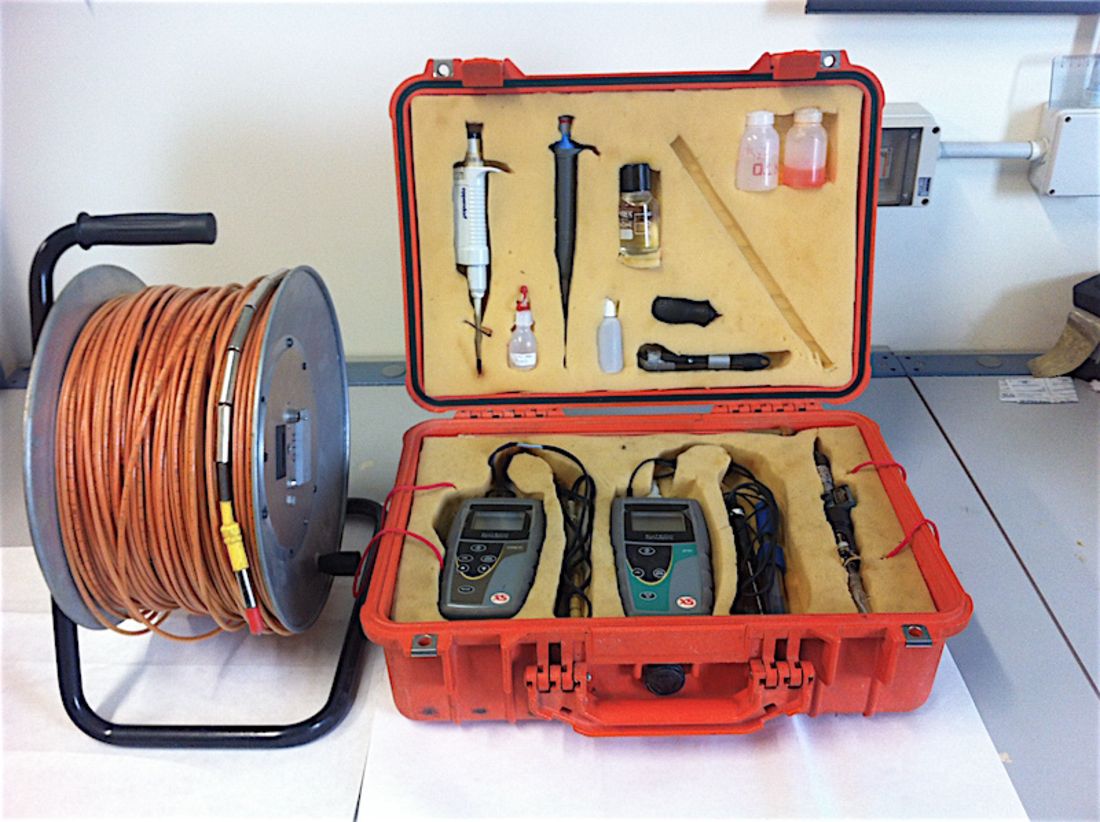
Gases
Sampling of natural gas manifestations and/or from geothermal wells are performed by means of the most suitable geochemical techniques. Available field equipment allows to collect samples of total fluids (using glass bottles partially filled with NaOH 4.5N aqueous solution) and also of separated condensed steam and no-condensable gas fraction (using condensator - which is specific for stable isotope analysis of hydrogen and oxygen of the steam fraction and for carbon monoxide being determined in a no-condensable fraction). Dissolved gases can be collected using glass bottles equipped with three-way stopcock for high vacuum.
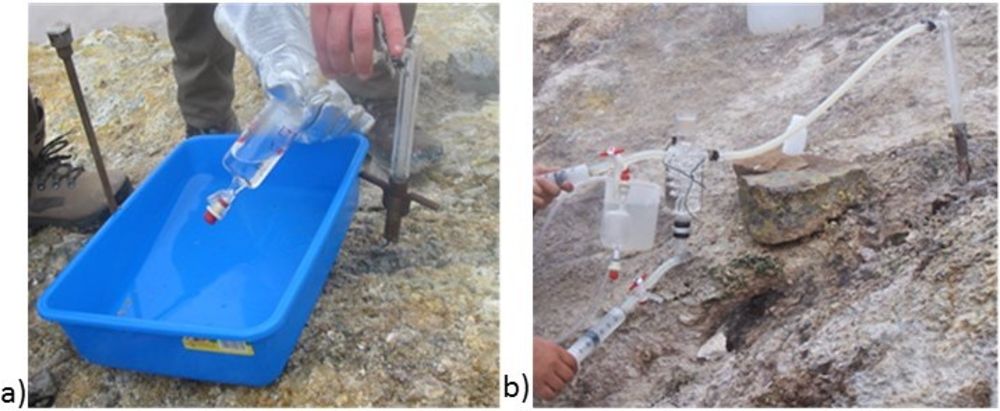
Field activities also include measurements of diffuse degassing (in particular for CO2 and CH4), using the accumulation chamber method. Flux measurements are performed in geothermal and volcanic areas, but also in areas characterized by the presence of faults/fractures.
Laboratory analyses
Well-known analytical methods to determine the contents of elements/compounds present in collected samples were routinely used. However, depending on the nature and characteristics of samples (in particular in terms of total dissolved solid contents), suitable different approaches can be used for sample preparation/treatment or for instrument calibration. Generally, instruments are calibrated daily with external single or multi-elements standards, which are analysed after each batch of samples (typically 12-15) in order to check the instrumental drift. Matrix matching strategies is generally used, but in case of complex matrices the standard addition strategy is preferred for some determinations.
Following chemical analyses are routinely performed in different kind of liquid samples, such as fresh waters (surface and groundwater), coastal and marine waters, thermal waters, geothermal/volcanic condensates and brines:
- Na, K, Ca, Mg, Li, Sr, B, Fe, Mn, As, Al, Ba, Be, Cd, Cr, Cs, Cu, Co, Hg, Ni, Pb, Rb, Sb, Si, Sn and Zn, using ICP-OES and ICP-MS.
- F, Cl, NO3, NO2, Br, PO4 and SO4, using IC.
- Low level F and NH3, using ISE-Potentiometry. High chloride contents and acid-base titration can be also performed.
- Monomeric silica (SiO2), using UV-VIS Spectroscopy.
For what concern gas samples, following compounds are routinely determined in geothermal/volcanic fluids from natural manifestations and/or geothermal wells, including dissolved gases in cold waters:
- H2O, CO2, Ar, He, O2, N2, CH4, H2S, H2, CO (CH4, H2 and CO can be determined also at ppm level), using Gas-chromatography.
Scientific applications
The activities of the Fluid Geochemical Laboratory span in several application fields of the Earth Sciences and Environmental Geochemistry. Main application fields regard geothermal exploration, volcano monitoring, soil degassing, hydrogeochemistry and isotope hydrology, chemical speciation and water-rock interaction study, identification of source and fate of contaminants, development of instrument prototype for geochemical applications (i.e. semi-continuous system for the determination of monomeric silica in geothermal brine, semi-continuous station for CO2 flux degassing, system for field measurements of the Total Dissolved Inorganic Carbon – TDIC).
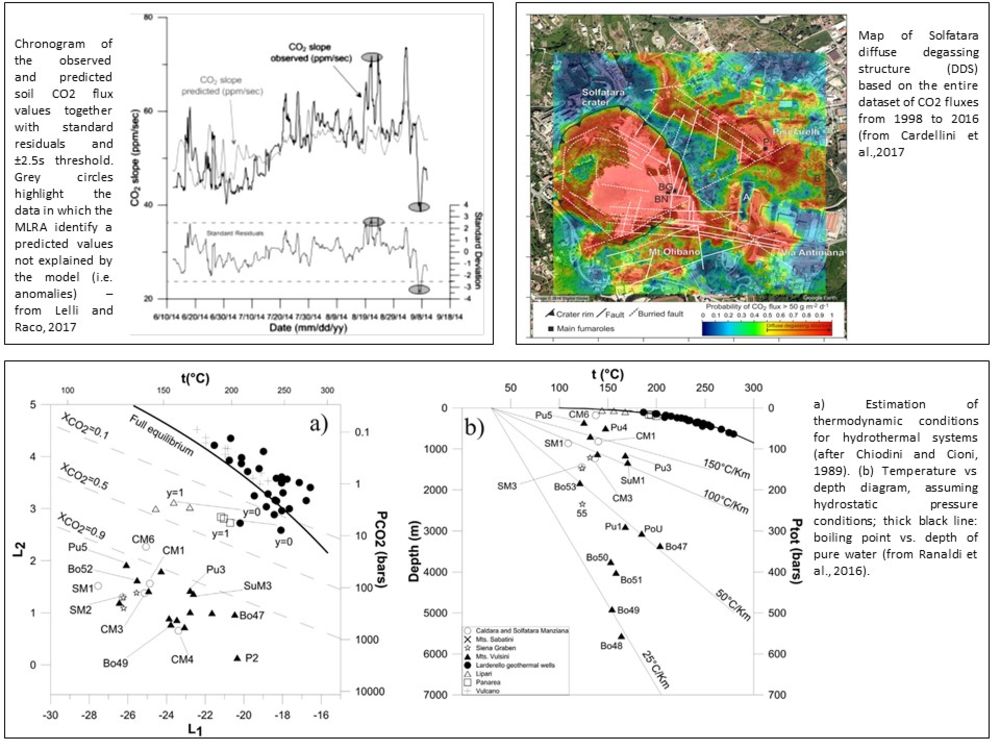
MAIN PROJECTS
- Geco– Geothermal Emission Control - (EU Horizon 2020)
- Gemex - Cooperation in Geothermal energy research Europe-Mexico for development of hot enhanced (hot-EGS) and super-hot geothermal (SGHS) systems – (EU Horizon 2020);
- Descramble “Drilling in dEep, Super-CRitical AMBients of continentaL Europe”” (EU Horizon 2020)
- CNR’s Researches in Arctic: ISMOGLAC (ISotopic and physical-chemical MOnitoring of GLACial drainages and sea water in the Ny-Alesund area, Svalbard islands - 2015), ARDISCO (Arctic DISsolved CO2, Svalbard islands, 2018) and Arctic Earth Critical Zone, Svalbard islands – 2018);
- Progetto Società Metropolitana Acque Torino (SMAT) - “Studio degli impatti del cambiamento climatico sui corpi idrici sotterranei di approvvigionamento per scopi idropotabili in area torinese” (2016-2018);
- Tuscany Region projects: “Realizzazione di uno studio multidisciplinare integrato geologico-ambientale nel bacino del Torrente Baccatoio”, regarding the contamination of thallium of tap water; 2) “I sentieri dell’Acqua dell’Isola di Pianosa” (2015-2016); 3) “Origin of hexavalent chromium in Val di Cecina, Tuscany Region (Italy) (2008-2010);
- Geothermal exploration in high enthalpy systems in Tanzania (Africa, 2016), Central and South America (2006-2013) and in Italian hydrothermal systems (2012-2016);
- MINeral SCale Program - European FP7 Marie Curie Initial Training Network (2012-2015);
- Progetto Parco Regionale Migliarino San Rossore Massaciuccoli – “Studio dell’intrusione salina nell’acquifero costiero pisano” (2012-2016).
- National project PRIN 2009 - “Study of the geochemical behavior of antimony: speciation in the aqueous solution and dispersion in abandoned mining areas”;
- “Hydrogeochemical monitoring of surface and groundwater around the Gello’s landfill (Pontedera, Italy) – 2007-2008;
- Programma quadro INGV-DPC 2005-2006: a) Progetto V3 “Research of active volcanoes, precursors, scenarios, hazard and risk”, Sub Project V3_1 Colli Albani; b) Project V5 “Diffuse degassing in Italy”;
- Programma quadro GNV-INGV-DPC 2000-2003: a) “Pericolosità associata alla risalita di fluidi endogeni nei Colli Albani (Roma)”; b) “Elaboration of a risk scenario for Civil Protection purpose in case of a submarine eruption to the East of Panarea Island”
The Fluid Geochemical Laboratory is selected for the European analytical network of the EPOS (European Plate Observing System) project.
SCIENTIFIC INTEREST
- Geochemical exploration aimed at the geothermal potential estimation and use of geothermal/hydrothermal resources.
- Monitoring of active and/or quiescent volcanic systems.
- Sustainable management of water resources and assessment of their quality, study and identification of sources and fate of contaminants.
- Soil flux monitoring for the identification of degassing structures (faults/fractures) and characterization (total output and chemical and isotopic composition) of gas emitted.
- Effects of climate change on waters in Polar Regions.
- Environmental monitoring in non-hazardous waste disposal sites.
- Study of the thermodynamic properties of specific ions complexes present in aqueous solution
PUBBLICATIONS
- Lelli M., Kretzschmar T., Cabassi J., Doveri M., Sanchez-Avila J.I., Gherardi F., Magro G., Norelli F. (2021). Fluid geochemistry of the Los Humeros geothermal field (LHGF - Puebla, Mexico): New constraints for the conceptual model. Geothermics, vol.90 – 101983.
- Venturi S., Tassi F., Cabassi J., Vaselli O., Minardi I., Neri S., Caponi C., Capasso G., Di Martino R.M.R., Ricci A., Capecchiacci F., Lelli M., Sciarra A., Cinti D., Virgili G. (2019). A multi-instrumental geochemical approach to assess the environmental impact of CO2-rich gas emissions in a densely populated area: The case of Cava dei Selci (Latium, Italy). Applied geochemistry 101, 109-126.
- Barcelona H., Lelli M., Norelli F., Peri G., Winocur D. (2019). Hydrochemical and geological model of the Bañitos-Gollete geothermal system in Valle del Cura, main Andes Cordillera of San Juan, Argentina. Journal of South American Earth Sciences, Vol.96, 102378.
- Ghezzi L., D'Orazio M., Doveri M., Lelli M., Petrini R., Giannecchini R. (2019). Groundwater and potentially toxic elements in a dismissed mining area: thallium contamination of drinking spring water in the Apuan Alps (Tuscany, Italy). Journal of Geochemical Exploration 197, 84-92.
- Doveri M., Lelli M., Baneschi I., Raco B., Trifirò S., Calvi E., Provenzale A. (2019). Glacial drainges and transfer of freshwater to the Artcic Ocean in Kongsfjorden (Svalbard). Geophysical Research Abstracts 21.
- Kretzschmar T., Lelli M., Alfaro R., Sanchez J.L., Ramos Y.R. (2019). Chemical and stable isotope composition of surface and groundwater in the surroundings of the Los Humeros Caldera, Puebla, Mexico. E3S Web of Conferences 98, 07013.
- Lelli M. and Raco B. (2017). A reliable and effective methodology to monitor CO2 flux from soil: The case of Lipari Island (Sicily, Italy). Applied Geochemistry 85, 73-85.
- Cardellini C., Chiodini G., Frondini F., Avino R., Bagnato E., Caliro S., Lelli M., Rosiello A. (2017). Monitoring diffuse volcanic degassing during volcanic unrests: the case of Campi Flegrei (Italy). Scientific reports 7 (1), 1-15.
- Ranaldi M., Lelli M., Tarchini L., Carapezza M.L., Patera A. (2016). Estimation of the geothermal potential of the Caldara di Manziana site in the Sabatini Volcanic District (central Italy) by integrating geochemical data and 3D-GIS modelling. Geothermics 62, 115-130.
- Molli G., Doveri M., Manzella A., Bonini L., Botti F., Menichini M., Montanari D., Trumpy E., Ungari A., Vaselli L. (2015) Surface - subsurface structural architecture and groundwater flow of the Equi Terme hydrothermal area, northern Tuscany Italy, Italian Journal of Geosciences, vol. 134: 442-457.
- Berro Himenez F., Lelli M., Minardi I., Virgili G. (2014). A procedure for eliminating sulfide interference on silica colorimetric analysis. Mineralogical Magazine, Vol. 78(6), pp. 1417-1422.
- Lelli, M., Grassi, S., Amadori, M., Franceschini, F. (2013). Natural Cr(VI) contamination of groundwater in the Cecina coastal area and its inner sectors (Tuscany, Italy). Environmental Earth Science, DOI: 10.1007/s12665-013-2776-2.
- Barberi F., Carapezza M.L., Cioni R., Lelli M., Menichini M., Ranaldi M., Ricci T., Tarchini L. (2013). New geochemical investigations in Platanares and Azacualpa geothermal sites (Honduras). J. Volcanol. Geotherm. Res., vol. 257, pp. 113-134.
- Naharro Rodrigo J., Nisi B., Vaselli O., Lelli M., Saldana R.,Clemente-Jul C., Perez del Villar L. (2013). Diffuse soil CO2 flux to assess the reliability of CO2 storage in the Mazarron-Ganuelas Tertiary Basin (Spain). Fuel, 114, 162-171.
- Apollaro C., Dotsika E., Marini L., Barca D., Bloise A., De Rosa R., Doveri M., Lelli M., Muto F. (2012). Chemical and isotopic characterization of the thermomineral water of Terme Sibarite springs (Northern Calabria, Italy). Geochemical Journal 46 (2), 117-129.
